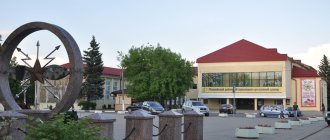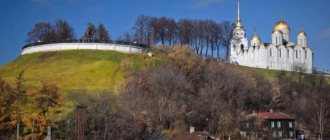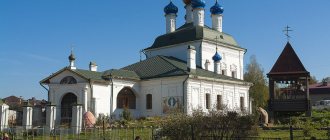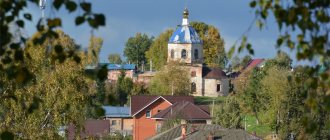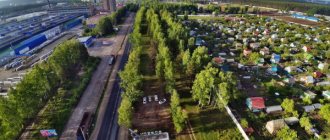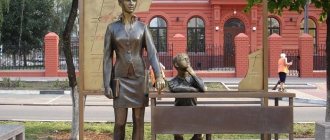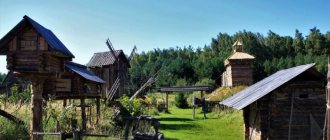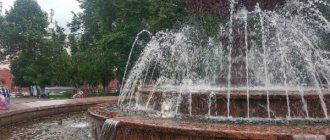63 km. To the west of Moscow is the city of Zvenigorod. The ancient Savvino-Storozhevsky monastery operates in the city. Zvenigorod is one of the most picturesque, ancient, glorious, beloved cities in the Moscow region, which has many historical, architectural and artistic monuments. However, the date of the founding of Zvenigorod is not in any of the surviving ancient Russian chronicles.
Zvenigorod history of the city.
The city was first mentioned in the spiritual charter of the Great Moscow Prince Ivan Kalita in the early 30s. XIV century From 1339 to 1492 Zvenigorod was the center of an appanage principality. On the western outskirts of the city there is a high hill called “Gorodok”, this is the ancient Zvenigorod Kremlin. Previously, there was a princely palace on Gorodok, but it has not survived to this day. The heyday of the city is associated with the name of its appanage prince Yuri Dmitrievich Zvenigorodsky. In 1398, it was on his instructions that a military outpost of the city was built - the Savvino-Storozhevsky Monastery on Mount Storozha.
Big Vyazemy Estate
Address: Bolshie Vyazemy village, Mozhaiskoe highway Telephone: Opening hours: from 10:00 to 17:00 (closed on Monday) Cost: 30 rubles for adults, 15 for children and pensioners (excursions - 290 and 215 rubles, respectively)
Together with the estate in Zakharovo, the Golitsyn estate in the village of Bolshie Vyazemy is part of the A.S. Pushkin museum complex. The estate was built at the end of the 16th century, when its owner was Boris Godunov. During these times, a large stone Transfiguration Cathedral and a whole complex of wooden buildings were built in the settlement, which included a princely tower, a monastery and surrounding fortress walls with towers. Thus, Bolshie Vyazemy was a full-fledged fortress with ramparts. Nowadays, only the stone cathedral has survived - all the buildings of that time have not reached us.
In 1694, the estate was transferred to Boris Golitsyn and fell into disrepair (the prince did not consider it his main one). During the 18th century, a clergy house, a stone fence of the cathedral, residential buildings and a princely palace were built here. In the 19th century, the estate was visited by Mikhail Kutuzov and Napoleon Bonaparte, participants in the Russian-French war. Later, Pavel I, Leo Tolstoy and the Pushkin-Hannibal family who lived nearby visited here.
During the Soviet era, the estate was abandoned and replaced by many different institutions, from a shelter for street children to a tank school. At the end of the 1980s, Bolshiye Vyazemy began to be restored and in 1994 became part of the museum. Nowadays excursions and educational activities are held here.
Zvenigorod in the XVII-XVIII centuries.
At the beginning of the 17th century, the city and the monastery suffered from Polish-Lithuanian invaders, and in 1812 the city suffered from French troops. In the 19th century, thanks to the picturesque nature, Zvenigorod and its surroundings, which are called Switzerland near Moscow, became one of the most popular and favorite summer cottages for Muscovites. N.M. rested and worked here. Karamzin, A.I. Herzen, A.P. Chekhov, I.I. Levitan, A.K. Savrasov, N.P. Krymov and many others.
Hannibal estate
Address: Zakharovo village, Moskovskoe Maloe ring, next to the Zakharovo railway station Telephone: Opening hours: from 10:00 to 17:00 (closed on Monday) Cost: 30 rubles for adults, 15 for children and pensioners (excursions – 140 and 90 rubles respectively)
The construction of the estate in the village of Zakharovo dates back to the 17th century. Its first owner was a Moscow governor, and in 1804 the complex was purchased by the grandmother of Alexander Sergeevich Pushkin, Maria Hannibal (the Zvenigorod Museum contains a document confirming this purchase). The future great poet spent almost every summer in Zakharovo before entering the Lyceum. After the grandmother’s stories, the story “Arap of Peter the Great” was written.
After starting her lyceum life, Maria decided to sell the estate, but Pushkin visited the places of his childhood several more times. Subsequently, the Hannibal building was destroyed, and at the beginning of the twentieth century it was rebuilt. During Soviet times, the house was a school for some time, was abandoned in the 80s, and burned down in 1993. For the 200th anniversary of the poet’s birth, the estate was restored for the second time.
Now the estate in Zakharovo is included in the historical and literary museum-reserve of A.S. Pushkin. There are alleys, parks and a pond here from the time of the poet’s childhood. There are three rooms with exhibitions on the territory; concerts, scientific works and educational activities for children are often held.
Zvenigorod and its attractions.
Arriving in Zvenigorod, you can visit the Assumption Cathedral “on Gorodok”, the Savvino-Storozhevsky Monastery with the white-stone Cathedral of the Nativity of the Virgin, the Refectory and Transfiguration Church with it, the belfry, the gateway Trinity Church, the palace of Tsar Alexei Mikhailovich, the Tsarina’s Chambers, the Fraternal Corps, powerful fortress walls and towers with tent roofs, and most importantly, enjoy the wonderful air and admire the rarest beauty of landscapes.
Museum of Russian Dessert
Address: st. Frunze, 23/2 Phone: , +7 (915) 093-70-93 Opening hours: from 10:00 to 20:00 daily Cost: free admission, excursions - from 250 rubles, lessons - from 600 rubles
In Zvenigorod there is an interesting museum that contains all the delicacies of Rus' - the dessert museum. The organizers gathered in one place the main symbols of different cities - Tula gingerbread, Belyov marshmallow, Kiev jam - and created a thematic museum. There are buffets here as showcases, and all the exhibits are edible. The entire interior of the museum is carefully designed and corresponds to the classical Russian style.
At the museum you can sign up for various thematic excursions. So, there is an information tour, in which visitors will be told a lot and given little food, and there is also an excursion for those with a sweet tooth - a real feast with stories and epics. The museum also regularly conducts master classes, cooking lessons, tastings and other events. The establishment has a store where visitors can buy sweets and souvenirs.
Savvino-Storozhevsky Monastery.
The monastery was founded in 1398 at the request of Prince Yuri Dmitrievich Zvenigorodsky. The confessor of Prince Yuri, Savva of Radonezh, became the rector of the monastery. In the center of the monastery in 1405, a white stone Cathedral of the Nativity of the Blessed Virgin Mary was built and has survived to this day, similar in architecture to the “Cathedral on Gorodok”. In 1652, during the Streletsky rebellion, the young Tsars Ivan and Peter and their sister Sophia hid in this monastery.
Cathedral of the Nativity of the Virgin.
The pearl and organizing center of the architectural ensemble is the Cathedral of the Nativity of the Virgin. It stands on the highest point of the hill. The Nativity Church is the most valuable monument of early Moscow architecture; it is one of the five most ancient stone churches of the Moscow princes
twa. There is no date of its construction in the chronicles, but researchers agree on the first decade of the 15th century. Despite the later additions that distorted the original forms of the temple, and the updated dome, dazzlingly shining with yellow gold, the Nativity Cathedral is beautiful in its true antiquity. Its white stone walls are decorated with fine carvings and frescoes from the 17th century, restored by autumn 2011.
A little about the city
Zvenigorod, a suburb of Moscow, is located 70 kilometers from the center of the capital in a westerly direction. The area of the city is about 50 square kilometers, the population is 22.5 thousand people. The climate is moderate continental.
Historical features of the city
Archaeological research indicates the presence of a fortress on the territory of the city at the end of the 12th and beginning of the 13th centuries. The founding date of the city is considered to be 1152. But the first mention in the chronicle occurs in 1339, when the Zvenigorod appanage principality was formed, which existed until 1492. The city was ravaged several times by nomads, and in the Time of Troubles it was burned twice by pretenders to the Moscow throne.
Since 1708, the city became part of the Moscow province, and in 1871 it became the center of the county. But industry in Zvenigorod developed poorly - only small factories and handicrafts worked. This feature of the city has been preserved to this day - there are no large industries here, but a rich infrastructure for tourism and recreation has been created.
How to get to Zvenigorod
The city has a railway station and a bus station.
- From the capital's Savelovsky and Belorussky railway stations you can travel by train in 1 hour 45 minutes or by high-speed train in 1 hour to the Zvenigorod railway station, which is located 3.5 kilometers from the city center, which can be reached by public transport.
- The bus journey from Moscow takes 1 hour and 20 minutes. Buses depart from the Tushinskaya, Kuntsevskaya, Strogino metro stations and stop at any city stop.
- It is easily accessible by car via highways heading west.
You can get to Zvenigorod from Moscow by car along western federal highways
Architecture of the monastery.
Many benches have been thoughtfully installed on the monastery territory. You can sit on any of them and look at buildings of different times and styles: the elegant Trinity Gate Church (1652), the austere palace of Alexei Mikhailovich (17th century), the Tsarina’s Chambers (mid-17th centuries), similar to a fabulous painted tower, a multi-faceted belfry directed upward (mid-17th century), a laconic Church of the Transfiguration of the Lord (17th century), monastery chambers, a refectory.
Gate Trinity Church of Savvino-Storozhevsky Monastery.
The church, built by the architect I.M. Sharutin in 1652, together with the Red Tower and the courtyard, forms a kind of propylaea of the monastery. The brick single-apse temple is completed with a decorative tent. Of particular interest is the layout and architectural and artistic design of the basement, where the main two-flight staircase leading to Cathedral Square is located. The technique of visually revealing the cathedral through its sequential perception as one ascends the stairs has no analogues in ancient Russian architecture.
Cathedral of the Assumption on Gorodok.
The town or Zvenigorod Kremlin is located on a high hill. To this day, artificial earthen ramparts with a height of 2 to 8 meters have been preserved in Gorodok. In the center of the ancient Kremlin, the white-stone Assumption Cathedral was built, which has survived to this day under the name “Cathedral on Gorodok”. The cathedral preserves frescoes, the author of which is called the greatest icon painter, monk Andrei Rublev.
Ascension Cathedral.
The stone church in the style of classicism - a two-story, single-domed quadrangle with a refectory and a multi-tiered bell tower - was built no later than the 16th century. The refectory, built in 1838, housed the chapels of St. Nicholas the Wonderworker and Our Lady of Tolga. Closed in 1930, broken down in 1941, leaving a vacant lot in place of the church. In 1998, a small memorial chapel was erected instead of the temple. In 2003-2007, a new brick church with the same three altars was built on the old site. This is a four-pillar, five-domed brick building in the neo-Byzantine style.
Beautiful city streets
- Moskovskaya Street The central street of Zvenigorod, Moskovskaya, forms the entire image of the city. On this street you can see both examples of the architecture of the old city and modern buildings. On it stands, among others, the Ascension Church. Now Moskovskaya Street is actively changing, being rebuilt and expanded.
- Frunze Street Adjacent to Moskovskaya, Frunze Street is like a guardian of the history of Zvenigorod. Old carved wooden houses have survived here, giving an idea of the architecture of the ancient city. The street runs above the Moscow River itself, next to hills covered with greenery.
If you have not yet chosen where you will live and want to save money when booking, we recommend using the RoomGuru service. Firstly, it contains hotels, apartments and guest houses from many different booking systems, so you won’t miss out on a worthwhile option. Secondly, you can immediately compare prices for one place in different services and book where it is cheaper (this is not always Booking!).
Church of Alexander Nevsky.
The Church of Alexander Nevsky in Zvenigorod is a brick church in the eclectic style. The quadrangle of the temple is completed with an octagonal drum with a tent covered with tin. A refectory and a two-tier rectangular bell tower are adjacent to the west. The temple was built in 1898-1902. designed by architect L.N. Shapovalova. In 1938 the temple was closed. It housed various institutions: from a women's dormitory to the Zvenigorod communications center. As a result, the building was rebuilt and lost its original appearance: in place of the central dome there was a radio broadcasting antenna. In 1991, the building was returned to the Church, and soon services began there. 1998 was also the year the children's Sunday school was opened. In 1999-2002 Restoration and interior decoration continued. The temple is open daily. Divine services are held on Saturdays and Sundays, as well as on special holidays.
Zvenigorod is one of the oldest cities in the Moscow region, famous for the beauty of its natural landscape and the most valuable monuments of ancient Russian architecture. Zvenigorod and its surroundings are a favorite vacation spot for residents of Moscow and other regions of Russia. This is facilitated by the unique landscape of the city, clean air, architectural and spiritual monuments of antiquity and the absence of industrial enterprises. Zvenigorod is also the cradle of Orthodoxy, the Assumption Cathedral on Gorodok is the oldest church in the Moscow region, and the Savvino-Storozhevsky Monastery has crossed the 600-year-old threshold.
House-Museum of Mikhail Prishvin
Address: Dunino village, building 2 Telephone: Opening hours: from 10:00 to 16:00 Wednesday - Sunday (before reconstruction) Cost: 150 rubles - entrance, 200 rubles - excursion (before reconstruction)
An interesting object near Zvenigorod (5 kilometers away, in the village of Dunino) is the house of the writer Mikhail Mikhailovich Prishvin. He settled here with his wife in 1946 and immediately fell in love with the local nature. Dunino reminded Prishvin of his native places in the Lipetsk region. The house itself stands out from the style of Russian villages, and the reason for this is the first owner of the house. She was a guest from Finland, who created a dacha in the Moscow region in the image of Finnish houses.
Mikhail Prishvin placed his hunter’s trophies in the house, his office and his wife’s spartan-furnished room were also located here. The writer’s car, Moskvich-41, is still in the garage. After the death of Mikhail Mikhailovich, his wife, Valeria Dmitrievna, became the caretaker and organizer of the museum. She herself led excursions and talked about her husband’s life. Now visitors can stroll along the alleys in the garden that Prishvin loved so much, look and touch his car, see hunting trophies and a collection of dishes.
Until November 2015, the museum is closed for reconstruction.


